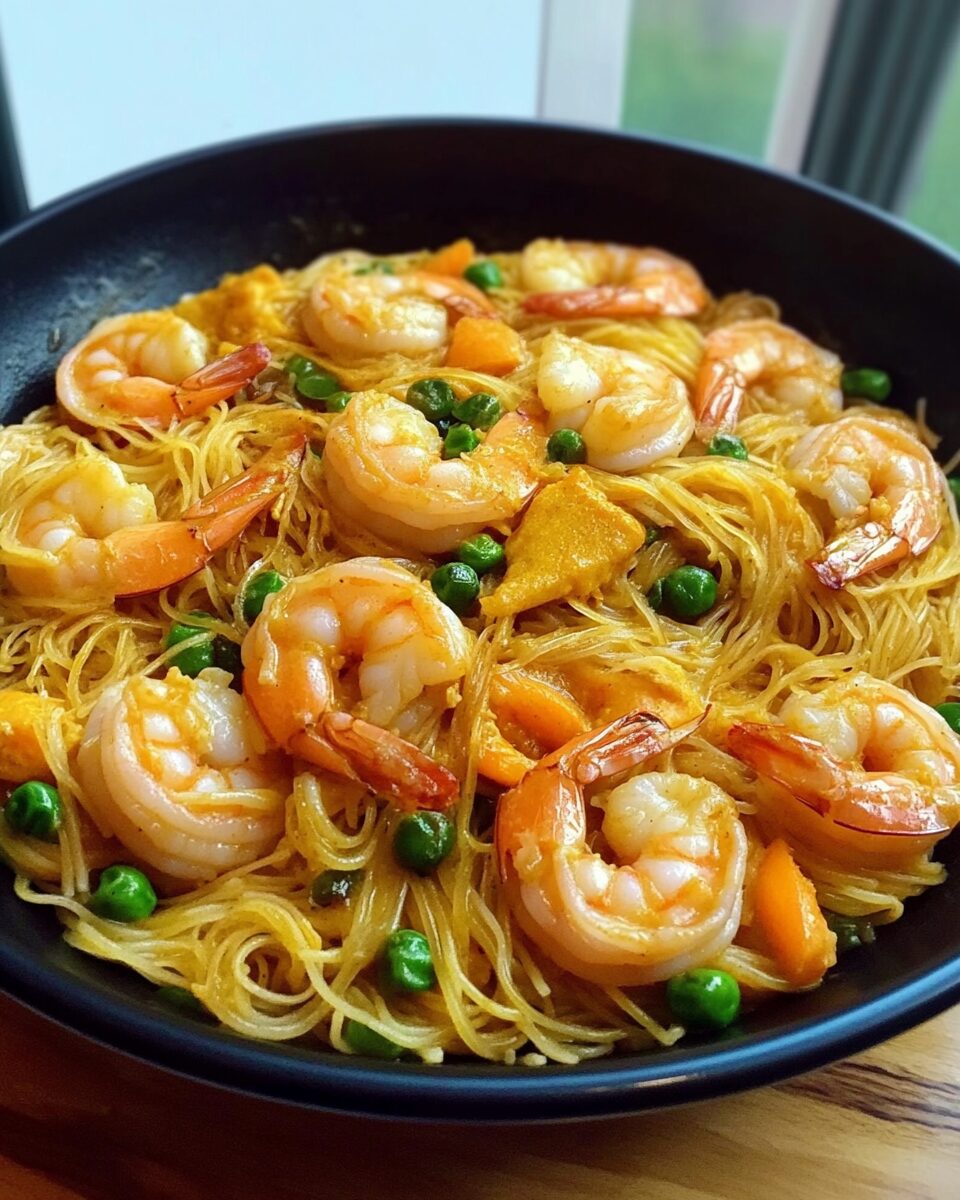Singapore Noodle Curry Shrimp is a flavorful and vibrant dish that combines thin rice vermicelli noodles with succulent shrimp, all tossed in a spicy curry sauce. Despite its name, this dish doesn’t originate from Singapore but is a popular creation in Chinese cuisine, particularly in Western countries. It’s known for its bright yellow hue, aromatic spices, and a delightful mix of textures.
Full Recipe:
Ingredients
- 6 ounces dried rice vermicelli noodles
- 1 pound extra-large shrimp, peeled and deveined
- 2 teaspoons fish sauce, divided
- 3 tablespoons vegetable oil, divided
- 2 teaspoons low-sodium soy sauce
- 2 teaspoons curry powder
- 1 teaspoon rice wine vinegar
- ½ teaspoon ground white pepper
- ½ small onion, halved and thinly sliced
- ½ orange bell pepper, seeded and thinly sliced
- ½ red bell pepper, seeded and thinly sliced
- 2 cloves garlic, thinly sliced
- 2 large eggs, lightly beaten
- 2 tablespoons chopped fresh cilantro, for garnish
Directions
- Prepare the Noodles: Cook the rice vermicelli noodles according to package instructions. Drain and set aside.
- Marinate the Shrimp: In a bowl, toss the shrimp with 1 teaspoon of fish sauce and set aside to marinate for about 10 minutes.
- Prepare the Sauce: In a small bowl, mix together the soy sauce, curry powder, rice wine vinegar, white pepper, and the remaining 1 teaspoon of fish sauce. Set aside.
- Cook the Shrimp: Heat 1 tablespoon of vegetable oil in a large skillet or wok over medium-high heat. Add the marinated shrimp and cook until pink and cooked through, about 2-3 minutes per side. Remove the shrimp from the skillet and set aside.
- Sauté Vegetables: In the same skillet, add the remaining 1 tablespoon of vegetable oil. Add the sliced onion, orange bell pepper, red bell pepper, and garlic. Stir-fry for about 3-4 minutes until the vegetables are tender-crisp.
- Scramble the Eggs: Push the vegetables to one side of the skillet. Pour the beaten eggs into the empty side and scramble until fully cooked.
- Combine Ingredients: Add the cooked noodles, shrimp, and sauce to the skillet. Toss everything together until well combined and heated through.
- Garnish and Serve: Remove from heat, garnish with chopped cilantro, and serve immediately.
Nutritional Facts
- Calories: Approximately 450 kcal per serving
- Protein: 35g
- Carbohydrates: 50g
- Fat: 15g
- Fiber: 3g
- Sodium: 800mg
Origins and Evolution of Singapore Noodles
Despite its name, Singapore Noodles is not originally from Singapore. The dish likely has its roots in Hong Kong or other areas of Southeast Asia, where Chinese immigrants settled and started to experiment with local ingredients and flavors. In many ways, it is a creation of Westernized Chinese cuisine, a fusion of local ingredients with traditional Chinese culinary techniques. While its exact origins are difficult to pinpoint, what we do know is that Singapore Noodles is a beloved dish in Chinese restaurants worldwide, particularly in countries with large Chinese communities such as the United States, Canada, and the United Kingdom.
Singapore Noodles is typically made with thin rice vermicelli noodles, which are known for their light and delicate texture. These noodles are paired with stir-fried vegetables such as bell peppers, onions, and carrots, and mixed with proteins such as shrimp, chicken, or pork. The dish gets its iconic yellow color from the use of curry powder, which imparts both flavor and vibrancy. The stir-frying technique used in preparing Singapore Noodles allows the ingredients to retain their individual textures while creating a harmonious blend of flavors.
While the dish may have originally been created for local palates, Singapore Noodles has evolved significantly over time, with numerous variations emerging across the world. Some versions of the dish incorporate additional spices or vegetables, while others use alternative noodles or proteins. Despite these variations, the core elements of Singapore Noodles remain the same: rice vermicelli noodles, curry powder, vegetables, and a protein, often shrimp or chicken. These variations reflect the global appeal of the dish and its ability to adapt to regional tastes.
Ingredients and Their Significance
The ingredients in Singapore Noodle Curry Shrimp come together to form a delightful balance of flavors and textures. The dish features several key ingredients, including rice vermicelli noodles, shrimp, curry powder, fish sauce, soy sauce, and vegetables like bell peppers and onions. Each of these ingredients plays a vital role in contributing to the overall taste and texture of the dish.
Rice vermicelli noodles are the base of this dish, providing a delicate and light texture that pairs perfectly with the bold flavors of the curry sauce. These noodles are thin and absorb the flavors of the stir-fried ingredients, allowing each bite to be a harmonious mix of tastes. They also provide a slight chewiness, adding substance to the dish without being overwhelming.
Shrimp is the protein of choice in this version of Singapore Noodles. Shrimp are not only quick and easy to cook, but they also have a natural sweetness that pairs wonderfully with the savory and spicy curry sauce. Shrimp also contribute to the dish’s texture, providing a satisfying contrast to the soft noodles and crunchy vegetables.
Curry powder is the key to giving Singapore Noodles its signature yellow color and rich flavor. Curry powder is a blend of various spices, including turmeric, cumin, coriander, and fenugreek, and it is the primary seasoning used to add depth and complexity to the dish. The use of curry powder gives Singapore Noodles a unique flavor that sets it apart from other noodle dishes. The warm, earthy spices in curry powder complement the shrimp and vegetables, enhancing the overall taste of the dish.
Fish sauce and soy sauce are both essential ingredients in Singapore Noodles. Fish sauce, made from fermented fish, adds a salty, umami-rich depth to the dish, while soy sauce contributes a savory, slightly sweet flavor. Together, these sauces create a well-balanced base for the stir-fry and elevate the dish’s flavors.
The vegetables in Singapore Noodles, such as bell peppers and onions, provide both color and crunch. These vegetables are lightly stir-fried, allowing them to retain their freshness and texture while absorbing the flavors of the sauce. The combination of vegetables adds a healthy component to the dish, making it a well-rounded meal.
The Stir-Frying Technique
Stir-frying is a cooking technique that originated in China and has been adopted across many Asian cuisines. It involves cooking ingredients quickly over high heat in a wok or large pan, typically with a small amount of oil. This technique allows the ingredients to retain their natural flavors and textures while being infused with the seasonings used in the dish. Stir-frying is particularly well-suited for dishes like Singapore Noodles, where the goal is to cook the noodles and vegetables quickly while ensuring they remain tender-crisp.
The high heat used in stir-frying also helps develop a depth of flavor through the Maillard reaction, which occurs when proteins and sugars react at high temperatures. This creates a complex, savory taste that enhances the overall dish. In Singapore Noodles, the stir-frying process is key to achieving the perfect balance of flavors, allowing the curry powder, shrimp, and vegetables to meld together while retaining their distinct textures.
One of the advantages of stir-frying is that it allows for the preparation of quick, one-pan meals. This makes Singapore Noodles a great option for busy weeknights when you want a satisfying meal without spending too much time in the kitchen. The stir-frying technique also ensures that the dish remains light and healthy, as it requires minimal oil and preserves the nutrients in the vegetables.
Nutritional Value of Singapore Noodles with Curry Shrimp
While Singapore Noodles with Curry Shrimp is a flavorful and delicious dish, it also offers a number of nutritional benefits. The dish is packed with lean protein from the shrimp, which are an excellent source of essential amino acids. Shrimp also provide important vitamins and minerals, such as vitamin B12, iodine, and selenium, which are important for overall health.
The rice vermicelli noodles in Singapore Noodles provide a source of carbohydrates, which are the body’s primary source of energy. While rice noodles are not as nutrient-dense as whole grains, they still offer essential nutrients and are a light, low-fat option that allows the dish to remain satisfying without being overly heavy.
The vegetables in Singapore Noodles, such as bell peppers, onions, and carrots, provide a wealth of vitamins and minerals. Bell peppers, for example, are an excellent source of vitamin C, which supports immune function and collagen production. The dish also contains a variety of antioxidants from the vegetables, which help protect the body against free radical damage.
In terms of fat content, Singapore Noodles with Curry Shrimp is relatively low in fat, as it is stir-fried with a small amount of oil. The healthy fats from fish sauce and soy sauce contribute to the dish’s flavor without adding excessive calories or unhealthy fats. If you wish to make the dish even lighter, you can reduce the amount of oil used during the stir-frying process or opt for a low-sodium soy sauce and fish sauce.
However, the dish does contain a moderate amount of sodium due to the use of soy sauce and fish sauce. To reduce the sodium content, you can use low-sodium versions of these sauces or adjust the amount used in the recipe. Overall, Singapore Noodles with Curry Shrimp is a balanced and nutritious meal that provides protein, fiber, vitamins, and minerals, making it a healthy option for both lunch and dinner.
Conclusion
Singapore Noodle Curry Shrimp is a versatile, flavorful, and visually appealing dish that offers a delightful combination of textures and tastes. Whether served as a main course for dinner or a satisfying lunch, this dish can be enjoyed by anyone who appreciates bold flavors and a touch of spice.





